At the turn of the century, there were two major administrative levels in the Ottoman Armed Forces, which were the “armies” and the “divisions”. The latter was directly linked to the former and there were no “corps” between them. In addition to their commanders, each army had a chief of staff (erkan-ı harp reisi) and a headquarters consisting of staff officers, whereas divisions had only a chief of staff and his deputies. Cadres of staff officers in both armies and divisions were low in number and working inefficiently. Although their primary duties covered training, operations and mobilization, they were usually asked to do routine paperwork. Additionally, it was often the case that staff officers were appointed to posts irrelevant to their specialization.
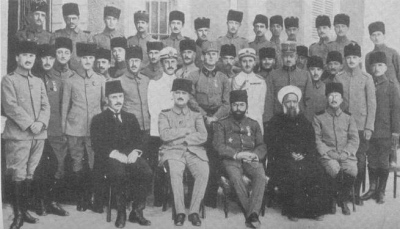
After the constitutional rule was reinstalled in 1908, a major reform initiative was commenced in the Ottoman Army. Army headquarters were modernized and due to the Turco-Italian War and Balkan Wars efforts to restructure the army were stepped up. Each army headquarters consisted of a chief of staff and specialized sections. The 1st Department was in charge of operations, the 2nd intelligence, the 3rd logistics and the 4th personnel. There were also support departments for supplies, medical and veterinary services. “Army corps” were established with a decree dated January 8, 1911 and as a result, a link was established between armies and divisions. The corps had also a chief of staff and relevant departments. Additionally, there were also judiciary bodies that were directly reporting to the corps commander. Divisions had a chief of staff and two deputies.
During the World War, new units were established that were incorporating more than one army. These were the “army groups” of which the best known are the “Yıldırım Army Group” and the “Orient Army Group”. Headquarters of these army groups had 15 and 14 departments respectively. Until the defeat in Palestine and Mustafa Kemal Paşa’s appointment as the commander of the Seventh Army, most of the staff posts in the Yıldırım Army Group were held by German officers and their influence was so great that even the correspondence within the headquarters was done in German language.
Army level headquarters consisted of a chief of staff, his deputy, seven departments and two inspectors, one for artillery and the other for engineering. Their logistics support was provided by “army logistics inspectorates”, which had 12 departments each (chief-of-staff, personnel, supplies, medical, veterinary, ammunition, transportation, automobile units, repairs, judiciary, post and telegraph, documentation).
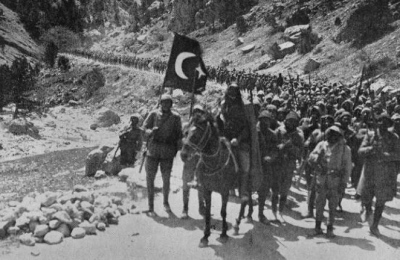
The organizational structure of corps and divisions remained unchanged during the war. Corps headquarters had ten departments each (operations, personnel, judiciary, supplies, secretariat, veterinary, documentation, artillery, engineering and post). Each headquarters had also one department for infantry, cavalry and field gendarmerie. Meanwhile, division headquarters had six departments each (operations, intelligence, judiciary, supplies, medical and veterinary). Headquarters of fortified zones were similar to those of divisions, but additionally they had special departments for documentation, artillery, engineering, communications and floodlight projectors.
As of 1908, the Ottoman Army had two main parts, which were the combatant and non-combatant (support) branches. The combatant branches were the infantry, cavalry and artillery, whereas the non-combatant branches included engineering, telegraph, communications, medical, veterinary, transportation and gendarmerie branches.
In 1914, at the outset of the World War, the Ottoman General Staff had four armies and the composition of their combatant units were as follows:
First Army: 5 Corps with 3 divisions each (15 divisions in total). Each division had 3 infantry regiments and an artillery regiment.
Second Army: 2 Corps with 2 divisions each (4 divisions in total). Each division had 3 infantry regiments and an artillery regiment. Additionally, a freestanding infantry division with 3 infantry regiments and an artillery brigade.
Third Army: 3 Corps with 3 divisions each (9 divisions in total). Each division had 3 infantry regiments and an artillery regiment. Additionally, four freestanding infantry regiments and four freestanding cavalry regiments (tribal units).
Fourth Army: 2 Corps with 2 divisions each (4 divisions in total). Each division had 3 infantry regiments and an artillery regiment.
Combatant branches
The infantry was the backbone of the army, as it has always been throughout Turkish history. It was the infantry whose job was to infiltrate into the enemy lines, protect the territory gained and obtain decisive results, even under the most difficult circumstances. It was branch that suffered the most casualties, but at the same time it was also the one that caused the enemy the greatest losses.
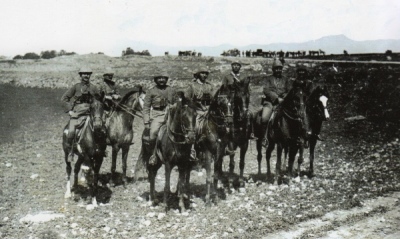
In battles prior to the Balkan Wars, 90 percent of the casualties inflicted on the enemy was the results of infantry operations, whereas this rate was 8 percent for the artillery and just 2 percent for the cavalry. However, these ratios soon began to change in favor of the artillery. Armies began to deploy rapid-firing guns and artillery began to gain the upper-hand and dominate the battlefield with new guns added to arsenals in big numbers.
New rapid-firing artillery guns, however, did not diminish the importance of the infantry in the army. In fact, the infantry benefited from the increased efficiency of artillery fire support. An important lesson drawn by the Turks from the Balkan Wars was that all the branches had to their utmost to support the infantry and there had to be optimal coordination among them. It was impossible to win a battle with superior artillery fire if the infantry did not perform well.
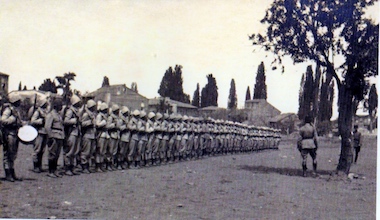
Advances in weapon technology led to changes in tactics and strategies, which meant that equipping the infantry only with conventional arms such as rifle, pistol, bayonet and hand grenade was not sufficient anymore. This was why, right before the Balkan War, machine guns entered the army. The general staff decided to allocate one machine gun company (with four machine guns) to each infantry regiment and in the year 1913, machine guns were already an established part of infantry units. During the course of the World War, the infantry was provided with further new weapons such as mortars and rifle bombs.
Although it had played a decisive role in battles throughout the history, the cavalry was losing its efficiency in late 19th and early 20th century, because it was not able to match rapid gun fire. Additionally, it was not suited to trench warfare, so its activities had to be limited. The Ottoman Army used its cavalry mainly for doing surveillance, distracting the advancing enemy, closing the gaps in army formations, attacking the enemy units low in numbers and chasing the retreating enemy.
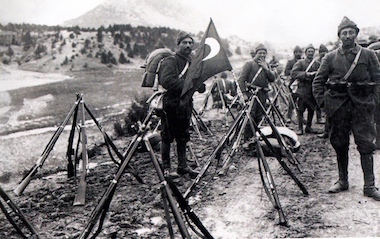
In the World War, the cavalry made up 15 percent of the Ottoman Army in terms of manpower. There were three kinds of cavalry: light cavalry, field cavalry and heavy cavalry. Light cavalry was mainly used by tribal units in East and Southeast Anatolia and they were using horses not taller than 150 cm. Horses used by field cavalry were 157 cm tall and those of the heavy cavalry were well built and 160 cm tall. The latter was practically non-existent because that particular kind of animals was not bred in Turkey and there were not enough financial resources to import them from overseas.
In 1911, artillery divisions had been abolished and the artillery units were attached to infantry divisions. Each division was provided with an artillery regiment and this structure was maintained during both the Balkan War and the World War. There were two kinds of artillery; the mobile field artillery and the heavy fort artillery. They possessed different kinds of guns, mountain guns, mortars and howitzers. Those used by the field artillery had calibers varying between 75-105 mm, whereas the heavy artillery had 105-305 mm guns, which were mostly used in fortified zones and coastal defenses. Each artillery battery had four guns.
Non-combatant branches
The army had an engineering branch, of which the duty was to remove the physical obstacles created by the enemy, to repair the damaged bridges and other facilities, to create obstacles to slow down the enemy and to build bridges and other infrastructure that would make it easy for the infantry units to undertake their operations. Each corps had an engineering battalion and each division had an engineering company. Among engineering units there were the ones specializing in building and demolishing bridges.
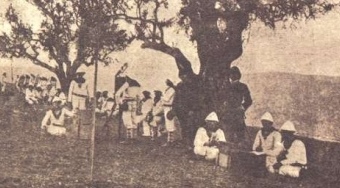
The communications branch in the Ottoman Army was established in 1882, after the Turco-Russian War. For a long time, these units operated telegraphs and the first telephone (purchased from Germany) was used in 1910. The next year, when the army went through structural changes, a communications unit (still called “telegraph battalion”) were allocated to each corps and freestanding division, a total of 17 companies. It was also in this year when the army began to use wireless equipment. Marconi brand equipment and stations (having ranges of 50 km and 150 km) were brought in use, which added a great deal to the communications capacity of the Ottoman Army. During the Turco-Italian War, communication between Turkey and Libya was carried out through the wireless stations located in Izmir and Derne.
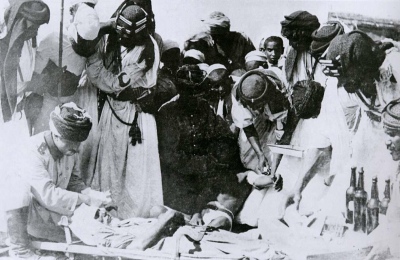
During the Balkan War, each of the 13 corps, five fortified zones and two freestanding divisions had a telegraph battalion. Given the demand fro better and more efficient communication telegraph units were upgraded from company to battalion in 1912. Each of the battalion had 15 pieces of wireless receivers. When the army mobilized for the World War, new telegraph units were established at army level. The wireless station in the Okmeydanı district of Istanbul, which had a range of 1100 km, was the main centre of communications and together with a new one built in Osmaniye, it enabled the Ottoman General Staff to communicate with the units in different fronts.
The gendarmerie organization was established in 1903 and it had two arms, which were the infantry gendarmerie and the cavalry gendarmerie. Its main task was to provide the homeland security, but it was also used as a combatant branch during wars. The largest unit in gendarmerie was the regiment and gendarmerie units were distributed to the regions in accordance with their security needs.
Protecting the health of the personnel and the animals in the army was a vital task during the war. The medical branch of the army consisted of doctors, surgeons, veterinaries, pharmacists, dentists, chemists, wound-dressers and nurses. The entire medical organization in the army was run by the Health department of the Ministry of War. During wartime, each army had a health inspector, who was a general; each corps and division had a head-doctor and head-veterinary whose ranks were colonel (corps) and lieutenant-colonel (division). Armies, corps and divisions had medical units and the main centers of healthcare were the Red Crescent hospitals, field hospitals and mobile hospitals. In addition to the officers, there were also privates serving in medical units, whose duties included attending the wounded on the field and taking care of the patients in the hospital.
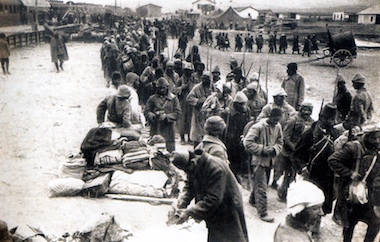
Ottoman military bands, known as the Mehteran, are thought to be the oldest variety of military marching band in the world. Mehteran units accompanied the janissaries in all campaigns through out the history of the Empire, but they were abolished in 1826 as a part of the modernization process in the army. New European-style military bands were established under the guidance of the Italian Maestro Giuseppe Donizetti. In early 20th century, the strongest military band was the “Imperial Band” (mızıka-i humayun) that consisted of 90 musicians. Each regiment had its own band and in 1908, the year when the constitutional rule was reinstalled, there were 35 military bands in Istanbul. Additionally, each town in Anatolia and each army headquarters had two bands. A major reform process in the military band organization was launched in 1911, which took the contemporary French military bands as an example.
Recruitment
The Ottoman Army had a quite sophisticated system of recruitment that was modeled on that of the German Army and shaped through several phases of reformation. The main system was conscription, which was complemented by voluntary and paid services when there was a shortage in manpower.
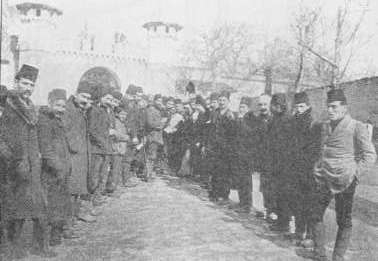
Until the proclamation of the constitutional rule in 1908, the legal framework of military recruitment was provided by a law dated 1886, which was later revised in 1909. Accordingly, military service was obligatory for all male Ottoman subjects, regardless of their nationality and religion, including those residing overseas. Prior to 1909, only Muslim citizens had the military obligation. In October that year, the recruitment of conscripts irrespective of religion was ordered for the first time.
Conscription of non-Muslims, which made up nearly one sixth of the population of the Empire at the time, remained a question because of the mistrust towards them. They were usually left unarmed and instead they served in labour battalions, doing repair work on the roads and railways and carrying supplies to the front. As Eric Jan Zürcher states: “The army feared that an intake of Christian peasants would be a burden to it and that non-Muslims would damage morale. This was a serious point, because, as all observers of the Ottoman army between 1850 and 1918 agree, the fighting spirit of the Ottoman troops was to a very high degree religious. Attacks were always carried out under simultaneous shouting of ‘Allah, Allah’ and ‘Allahüekber’ (God is great). It would be hard to envisage a religiously mixed army to do the same. Most Muslims, especially in the countryside, disliked the idea of Christians bearing arms.”
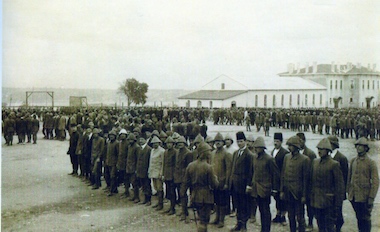
The military obligation began on the first day of March in the year when the individual involved was 20 years of age. The total duration of the military service in the Army was 25 years, during which three years were for active duty, six years for reserve, nine years for “redif” and seven years for home guard. For the Navy, the total duration of service was 20 years in which five years were for active duty. There were no home guards in the Navy.
Although, in theory, all male Ottoman subjects had to serve in the armed forces, the recruitment was remarkably inefficient. The lack of an accurate census made it especially difficult for the authorities to get all those who were liable to serve to take part in the draft. Additionally draft dodging was quite easy, especially in the country side.
What made the recruitment problem even more serious was the large proportion of those exempted from military service. To begin with, residents of certain regions were exempted from military service. These regions were Istanbul, Tirana, Shkoder, Yemen, Hejaz, Necit (in Basra region) and Tripoli. Arab tribes were exempted as well. It was an army of Anatolian Muslim men, with an overwhelming majority of Turks. As over 80 percent of the population was rural, the Army was primarily one of sedentary Muslim peasants.
Exemptions were also granted to individuals who could show that they were without support or sole breadwinner in their household. Servants of the Sultan in the palace and in imperial farms, professors in certain branches, judges in active duty, sheikhs of religious clans, mosque imams, servants in holy places in Mecca and criminals who received sentences of more than five years were exempted as well. Additionally there was a system of “bedel-i nakdi” (cash payment-in-lieu) which allowed those who can pay 50 golden liras to buy exemption. After three months of basic training, those who had bought their exemption were declared reservists, until a change in the law, which stipulated that they should serve for six months with the active army and only then be classified as reservists.
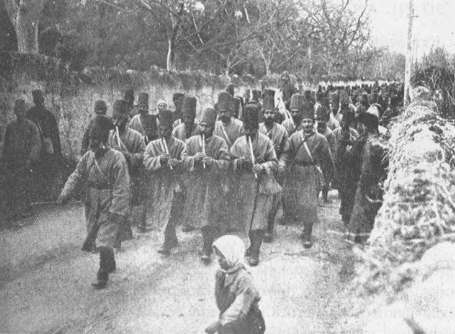
A new recruitment law was issued on May 12, 1914 which supported the mobilization efforts of the Ottoman Army. This new law lowered the conscription age from 20 to 18 and abolished the “redif” system. Active duty lengths were set at two years for the infantry, three years for other branches of the Army and five years for the Navy, however during the course of the World War, these measures remained largely theoretical.
Volunteers had traditionally a special place in the Army, which lasted for centuries but somehow diminished after the Turco-Russian War of 1877-78. Later on, it began to regain its importance. The Turco-Italian War of 1911 was an undertaking completely carried out by volunteer officers. Volunteers also played a significant role in the recapture of Edirne in the Balkan War.
Several groups and individuals in the Ottoman society volunteered for active duty during the World War, with the major examples being the “Mevlevi” (a Sufi order founded by the followers of Mevlana Celaleddin-i Rumi in Konya) and the “Kadiri” (another Sufi order founded by Sheikh Ismail Rumi in Istanbul). In addition to the battalions formed by these Sufi orders, there were also units formed by Caucasian and Rumelian Turks (such as the “Osmancık Battalion” led by Lt. Süleyman Askeri) who took part in the battles in Mesopotamia and Palestine. Volunteers were not only Turks; there were also Arab and Bedouin volunteers who supported the campaign against the British to capture the Suez Canal.
Volunteerism, however, did not provide a substantial support for the efforts of the Army. Turkish volunteers were not trained well, whereas most of the Arab and Bedouin volunteers were motivated by financial gains. As the end of the war approached, this system disappeared by itself.